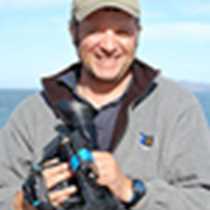La Entrada & Hull Canal
We began our morning amidst the swells of the open ocean. We were completing our northward navigation toward La Entrada, the southern entrance to Magdalena Bay. To starboard we could see the desert hills of Isla Margarita. To port lay the endless, sparkling expanse of the Pacific.
As the morning progressed we were joined, several times, by pods of long-beaked common dolphins. Leaping groups of them swooped in to ride the bow, surfing effortlessly on the pressure wave created by our ship. It seemed like they were playfully escorting us North.
As we neared La Entrada we began to spot the distinctive, heart-shaped blows of gray whales. One whale breached three times as if marking the spot for us to enter the bay. We made our turn and the swells dropped away. Now we were in smooth waters, cruising forward with whales on every side.
The rest of our expedition will take place here in Bahia Magdalena. This huge body of water is one of several bays along the Pacific side of the Baja Peninsula where gray whales come to breed and calve.
The transit from La Entrada to our anchorage at the northern end of the bay took us through the Hull Canal, a narrow, sinuous stretch of water between Magdalena Island and the main body of the Baja Peninsula. In places it is less than 30 meters wide and so shallow that our keel passes just a few feet above the bottom. To navigate this challenging canal we brought aboard a local pilot, Alejandro Camacho, who has been driving ships through these waters for decades.
Near the entrance to the canal we were greeted by bottlenose dolphins. This was the seventh species of cetacean we’d spotted so far on this expedition. As they rode our bow through the clear, green water they’d occasionally turn on their sides, seeming to glance up lazily at those of us who leaned down, delighted, to watch them.
With Mr. Camacho’s sure hand at the wheel we progressed up the Hull Canal, passing between banks thick with tangles of mangrove, where tri-colored herons, snowy egrets and a host of other birds roost and nest. Intrepid birders on the bow spotted neotropical cormorants, white ibis and yellow-crowned night-herons.
Near its northern terminus, the canal widens and deepens. Here we entered the calving grounds of gray whales. It wasn’t long before we spotted heart-shaped blows and mottled gray backs. Drawing closer we could see the smaller blows of calves swimming close beside the flanks of their mothers.
We dropped anchor near the Boca de Soledad, the northern entrance to the bay. Since we’d spent the whole day aboard the ship we took our Zodiacs to shore in order to watch the sunset from land. We crossed wind-sculpted dunes to a long, wide beach and watched the day end over the thundering breakers of the Pacific, knowing that further adventure awaits.
We began our morning amidst the swells of the open ocean. We were completing our northward navigation toward La Entrada, the southern entrance to Magdalena Bay. To starboard we could see the desert hills of Isla Margarita. To port lay the endless, sparkling expanse of the Pacific.
As the morning progressed we were joined, several times, by pods of long-beaked common dolphins. Leaping groups of them swooped in to ride the bow, surfing effortlessly on the pressure wave created by our ship. It seemed like they were playfully escorting us North.
As we neared La Entrada we began to spot the distinctive, heart-shaped blows of gray whales. One whale breached three times as if marking the spot for us to enter the bay. We made our turn and the swells dropped away. Now we were in smooth waters, cruising forward with whales on every side.
The rest of our expedition will take place here in Bahia Magdalena. This huge body of water is one of several bays along the Pacific side of the Baja Peninsula where gray whales come to breed and calve.
The transit from La Entrada to our anchorage at the northern end of the bay took us through the Hull Canal, a narrow, sinuous stretch of water between Magdalena Island and the main body of the Baja Peninsula. In places it is less than 30 meters wide and so shallow that our keel passes just a few feet above the bottom. To navigate this challenging canal we brought aboard a local pilot, Alejandro Camacho, who has been driving ships through these waters for decades.
Near the entrance to the canal we were greeted by bottlenose dolphins. This was the seventh species of cetacean we’d spotted so far on this expedition. As they rode our bow through the clear, green water they’d occasionally turn on their sides, seeming to glance up lazily at those of us who leaned down, delighted, to watch them.
With Mr. Camacho’s sure hand at the wheel we progressed up the Hull Canal, passing between banks thick with tangles of mangrove, where tri-colored herons, snowy egrets and a host of other birds roost and nest. Intrepid birders on the bow spotted neotropical cormorants, white ibis and yellow-crowned night-herons.
Near its northern terminus, the canal widens and deepens. Here we entered the calving grounds of gray whales. It wasn’t long before we spotted heart-shaped blows and mottled gray backs. Drawing closer we could see the smaller blows of calves swimming close beside the flanks of their mothers.
We dropped anchor near the Boca de Soledad, the northern entrance to the bay. Since we’d spent the whole day aboard the ship we took our Zodiacs to shore in order to watch the sunset from land. We crossed wind-sculpted dunes to a long, wide beach and watched the day end over the thundering breakers of the Pacific, knowing that further adventure awaits.




